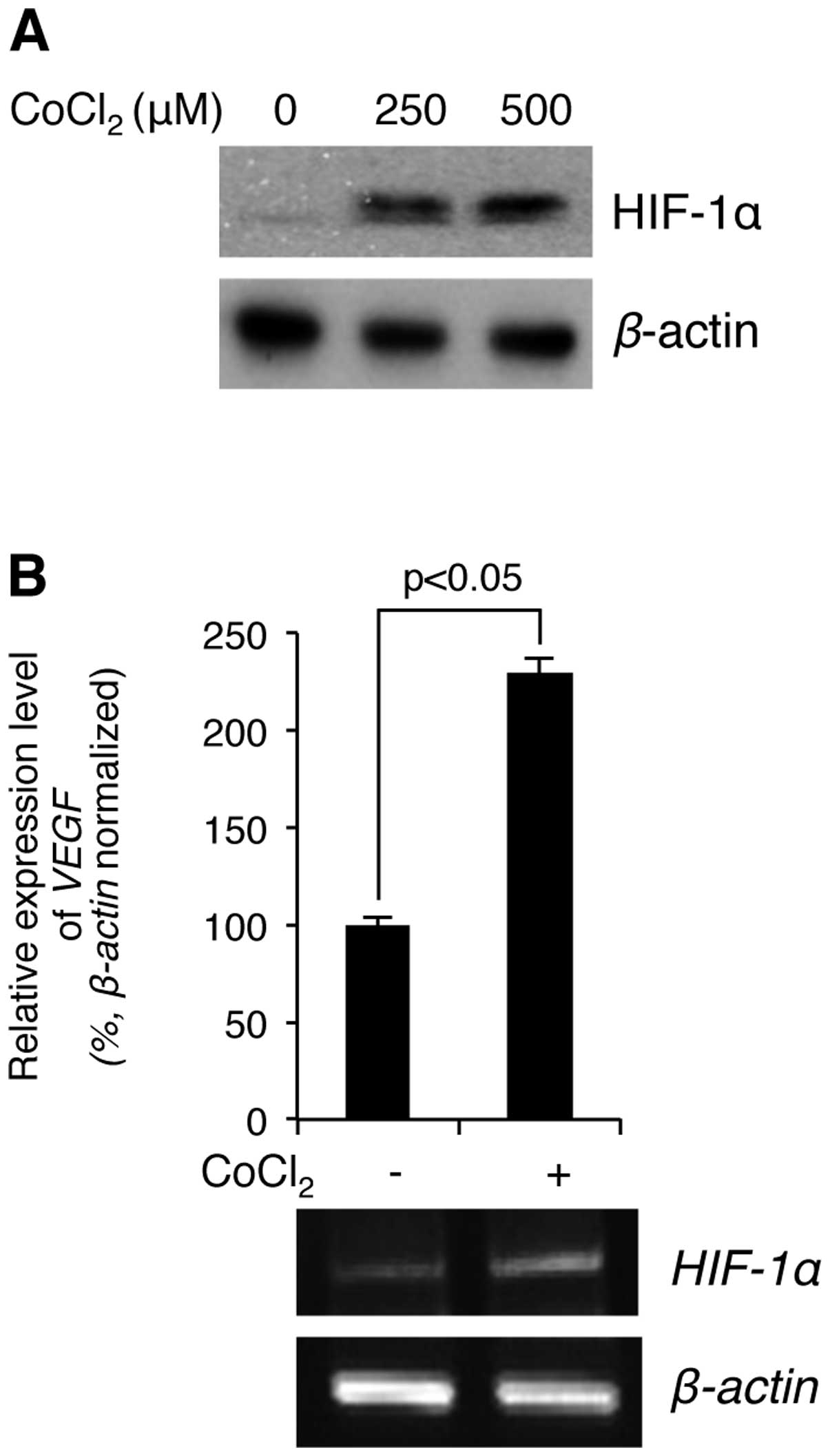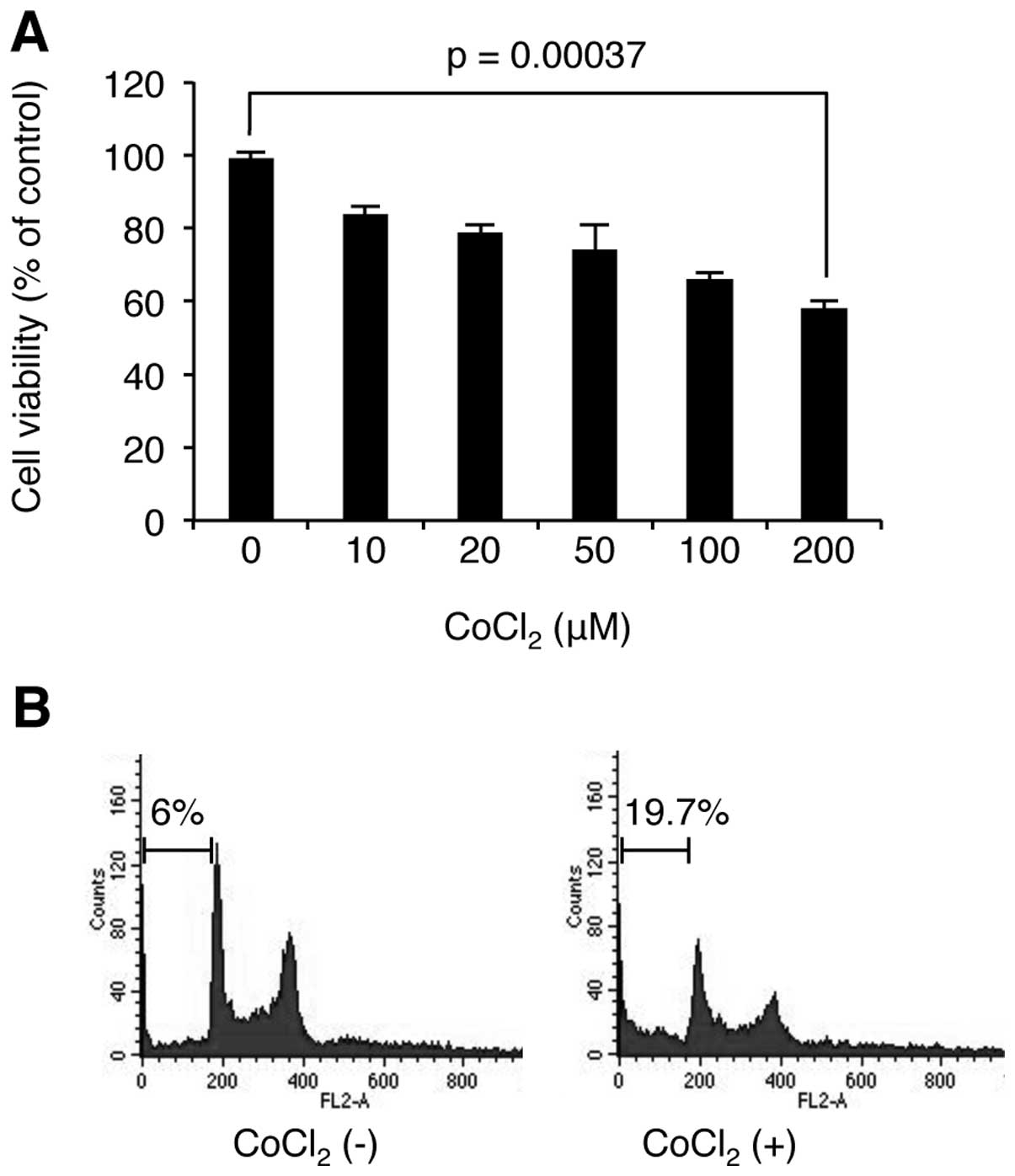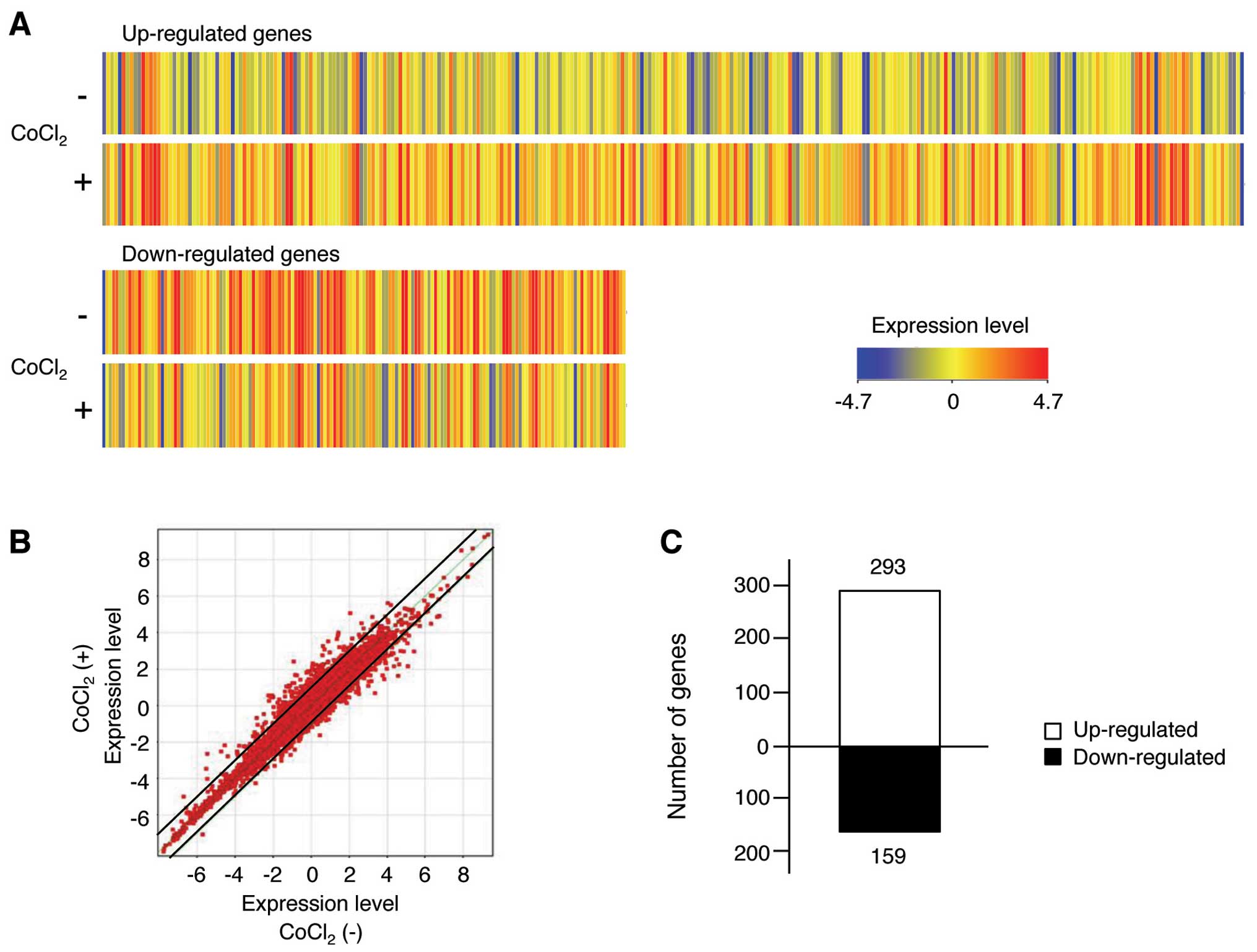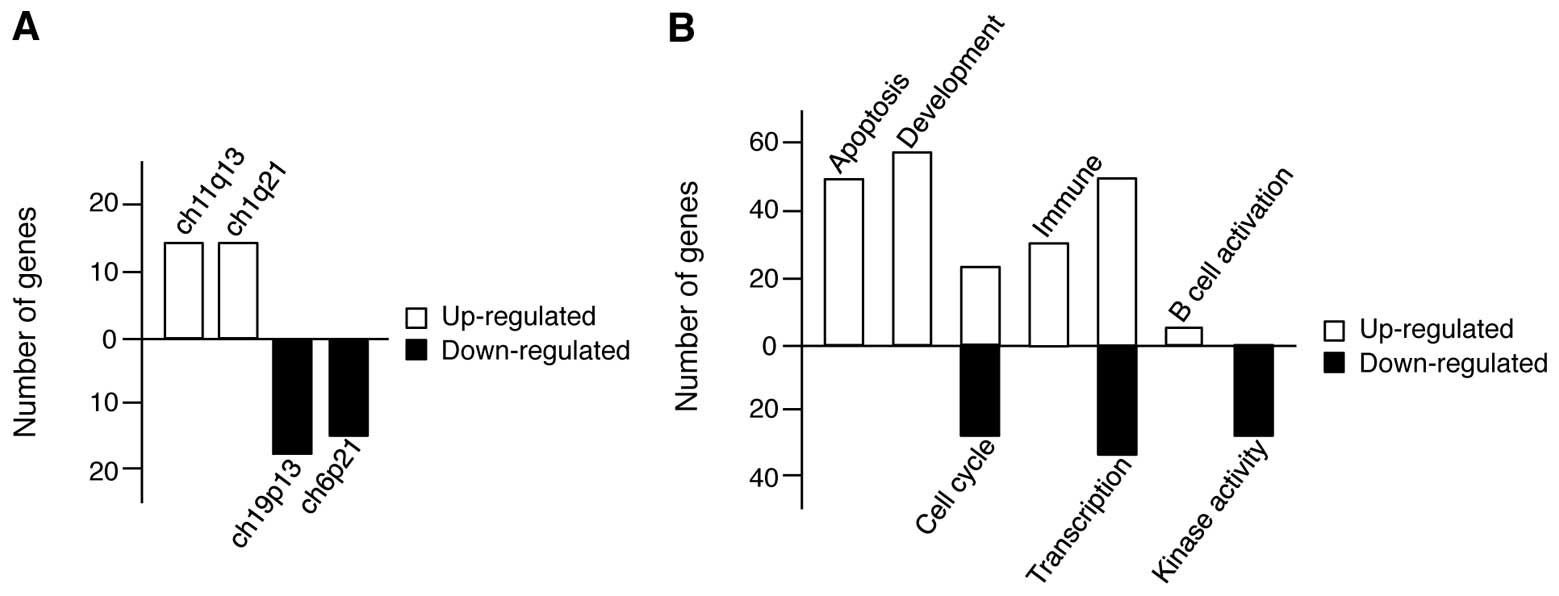The hypoxia-mimetic agent cobalt chloride induces cell cycle arrest and alters gene expression in U266 multiple myeloma cells
- Authors:
- Published online on: August 31, 2012 https://doi.org/10.3892/ijmm.2012.1115
- Pages: 1180-1186
Abstract
Introduction
Hypoxia, defined as areas with oxygen tension values of 10 mmHg or lower, is a common feature of solid tumors that occurs across a wide variety of malignancies (1,2). Once cells encounter hypoxia, a large number of genes that stimulate adaptation to oxygen deprivation are induced. These hypoxia-inducible genes are primarily controlled by the transcription factor hypoxia-inducible factor 1 (HIF-1), including those involved in cell cycle arrest, apoptosis, erythropoiesis, angiogenesis, glycolytic metabolism, and tumor invasiveness (2,3). HIF-1 is a heterodimer consisting of a constitutively expressed HIF-1β subunit and a HIF-1α subunit that is regulated in an oxygen-dependent manner (3). Under hypoxia, HIF-1α can block its own degradation and thus induce its accumulation (3). Therefore, HIF-1α is overexpressed in many cancer types and is associated with poor prognosis in cancers of the breast, brain, cervix, ovary, and uterus (3).
HIF-1α activation in response to hypoxia stimulates the transcription of several of its target genes. Vascular endothelial growth factor (VEGF), which is known to promote angiogenesis, is strongly induced by HIF-1α (4). In addition, matrix metalloproteinase (MMP)-1 and MMP-2 are induced to promote intravasation (5,6). Additionally, the epithelial-mesenchymal transition-inducing genes E-cadherin, SNAIL, TWIST, TCF3, and ZEB1 are up-regulated in a HIF-1α-dependent manner (7–9). Interestingly, HIF-1α also induces cell cycle arrest by up-regulating p53, p21, and E1B 19K/Bcl-2 binding protein Nip3 expression (10–12). These findings suggest that there are different adaptive responses to oxygen deprivation.
Cobalt chloride (CoCl2), a commonly used hypoxia-mimetic agent, artificially induces hypoxia and can block the degradation and thus induce the accumulation of HIF-1α protein (13,14). Many reports have indicated that both CoCl2 and hypoxia regulate a similar group of genes on a global gene expression level (15–17). In addition, the reports demonstrated that hypoxia and CoCl2 induced different effects in many different types of cells. For example, CoCl2 induced apoptosis in rat C6 glioma cells, human alveolar macrophages, neuronal PC12 cells, and HeLa human cervical cancer cells, although it inhibited apoptotic death in HepG2 hepatoma cells (18–22). Moreover, CoCl2 induced prostate tumor cell adhesion, metastasis, and angiogenesis (23–25) and stimulated oral squamous carcinoma cell growth (26).
Multiple myeloma (MM) is a B-cell malignancy selectively localized in the bone marrow (BM) (27). Unlike other organs, the normal BM microenvironment is hypoxic. This physiological hypoxia is crucial for normal marrow hematopoiesis (28). In several studies, oxygen levels in BM in mice with MM were depressed (29,30). This hypoxia is an important microenvironmental stimulus for activities critical for MM disease progression such as MM cell growth, drug resistance, and angiogenesis (29,30). However, how hypoxia and MM affect each other is poorly understood. Therefore, an investigation of the effects of hypoxia on myeloma cells is necessary.
Materials and methods
Cell culture
The human multiple myeloma cell line U266 was purchased from the Korean Cell Line Bank (Seoul, Korea) and cultured in RPMI-1640 medium containing 10% fetal bovine serum and antibiotics at 37°C in a humidified chamber containing 5% CO2. Cells were seeded into 60-mm culture dishes (4×105 cells per dish) 1 day before CoCl2 (Sigma, St. Louis, MO, USA) treatment.
Hypoxia induction
CoCl2 was dissolved in dimethylsulfoxide (DMSO; Sigma) and added to U266 cultures at the indicated final concentrations. DMSO was added to culture medium alone as a vehicle control. Cells were treated for 24 h.
RNA preparation and cDNA synthesis
Total RNA was extracted from cells by using TRIzol reagent (Invitrogen, Carlsbad, CA, USA) according to the manufacturer’s instructions after the 24-h CoCl2 treatment. For the microarray studies, both the quality and concentration of the RNA samples were determined using an Agilent 2100 Bioanalyzer (Agilent Technologies, Santa Clara, CA, USA) and an Ultrospec 3300 Pro UV/Visible Spectrophotometer (Amersham Biosciences, UK). The recommended RNA quality parameters for microarray analysis are as follows: a UV spectroscopy A260/A280 ratio of 1.8–2.0 and an A260/A230 ratio >1.8, an 18S/28S rRNA ratio of 1.8–2.1, and an RNA integrity number >8.0. To synthesize cDNA, 1 μg of RNA was incubated with oligo-dT primers at 94°C for 10 min and reverse-transcribed with reverse transcriptase (Enzynomics, Seoul, Korea) at 37°C for 1 h.
DNA microarray analysis
DNA microarray analysis was performed using the HumanHT-12 v4.0 Expression Beadchip kit (Illumina, San Diego, CA, USA) according to the instruction manual. Derived data were analyzed using Genespring GX 11 (Agilent Technologies). The raw data were filtered using FLAG and t-tests. Significant genes were determined using the fluorescence ratio between the control and CoCl2-treated samples, and genes displaying a >2-fold increase or decrease were selected for analysis.
Immunoblotting and polymerase chain reaction (PCR)
Immunoblot analysis was performed as described previously (31). A primary antibody specific for HIF-1α was purchased from Cell Signaling Technology (Danvers, MA, USA). Anti-β-actin antibody was purchased from Sigma. The expression level of VEGF mRNA was determined by quantitative real-time (RT)-PCR using specific primers (forward, 5′-AAGGAGGAGGGCAGAATCAT-3′; reverse, 5′-GCTGTAGGAAGCTCATCTCT-3′). RT-PCR analysis was performed using Line-Gene K software (Bioer Technology Co. Ltd., Hangzhou, China).
Cell viability assay and FACS analysis
Cell proliferation was determined using the WST-1 assay (EZ-Cytox Cell Viability Assay kit, ITSBIO, Korea) according to the manufacturer’s instructions. In brief, 4×105 cells were seeded in 60-mm dishes. The cells were cultured for 24 h and treated with the indicated concentrations of CoCl2 for 24 h. At each time-point, the kit solution was added to cultured cells, which were incubated at 37°C for 30 min. Cell viability was measured using an iMark microplate reader (Bio-Rad, Hercules, CA, USA) at 450 nm by using a 620-nm reference filter. Cell cycle distribution was determined using FACS analysis. U266 cells were collected and fixed by resuspending them in 70% ethanol for 1 h, centrifuged, and washed in cold PBS. The cell pellets were resuspended in PBS containing 50 μg/ml propidium iodide (Sigma) and 100 μg/ml RNase, incubated at room temperature for 30 min, and then analyzed using a FACScalibur (BD Biosciences, San Jose, CA, USA).
Statistical analysis
Statistical analysis was performed using the χ2 test or Fisher’s exact test and Spearman rank correlation coefficient analysis. p<0.05 was considered significant.
Results and Discussion
We first examined whether CoCl2 stimulation induces hypoxia in MM U266 cells. The cells were treated with the indicated concentrations of CoCl2 for 4 h, and then the level of hypoxia was determined by immunoblotting against the hypoxia marker HIF-1α. As shown in Fig. 1A, the cellular protein levels of HIF-1α were greatly increased in a CoCl2 concentration-dependent manner. Further, to test whether the accumulated HIF-1α is functionally active in the cells, the expression level of a well-known HIF-1α target gene, VEGF, was verified by RT-PCR using its specific primers (see Materials and methods). As shown in Fig. 1B, the mRNA expression levels of VEGF were up-regulated by CoCl2 stimulation in U266 cells. Therefore, the hypoxia-mimetic agent CoCl2 induced hypoxia in U266 cells.
As hypoxia has dual roles in cell proliferation and cell death, we examined the effect of hypoxia on MM cell proliferation. U266 cells were stimulated with CoCl2 at the indicated concentrations for 24 h, and then WST-1-based cell viability assay was used to determine the level of cell proliferation. As shown in Fig. 2, CoCl2 decreased cell viability in a concentration-dependent manner. We next examined whether the loss of cell viability is related to cell cycle arrest or apoptosis. Interestingly, FACS analysis revealed that CoCl2 stimulation induces apoptosis, but not cell cycle arrest. These results indicate that the hypoxia induced cell death in U266 cells.
Although hypoxia alters cell type-specific gene expression patterns (32), its effects have been not fully studied in MM cells. Therefore, we analyzed mRNA profiles using Illumina Human HT-12 v4.0 Beadchip kits in hypoxia-stimulated and control U266 cells. A total of 47,000 human mRNAs were selected to analyze gene expression profiles. Those human genes were continually filtered with FLAG to obtain more defined data using Agilent GeneSpring GX 11 software. We selected total 452 human mRNAs as a result of FLAG filtration, and the genes displaying >2-fold differences in expression between the control and CoCl2-treated cells are shown in Fig. 3A. In addition, the mRNA microarray was visualized on a scatter plot (Fig. 3B). The data of the scatter blot demonstrated that many genes displayed >2-fold differences in expression levels between control and CoCl2-treated cells, as indicated by their distance from the diagonal line. The numbers of up- and downregulated mRNAs exhibiting >2-fold changes were derived from the expression patterns in each group. We found that 293 up-regulated and 159 down-regulated mRNA displayed meaningful changes in their transcription profiles in response to CoCl2 treatment (Fig. 3C). The 50 genes for which their expression was most strongly altered by CoCl2 are listed in Table I. To further analyze the changes in gene expression patterns, we sorted the genes displaying >2-fold changes in expression after CoCl2 treatment into several groups according to common features such as homology or biochemical activity by using the Gene Set Enrichment Analysis bioinformatics tool (www.broadiinstitute.org/gsea), and we revealed that the sorted gene sets were categorized into transcription factors, cell differentiation markers, cytokines and growth factors, protein kinases, tumor suppressors, and oncogenes (Table II). Moreover, we further identified the cellular process pattern of CoCl2-induced gene expression changes by using the gene ontology database. Although the analysis of cellular process pattern was firstly performed using genes with >2-fold changes in expression, the pattern results were not sufficient for elucidation because the p-values of each category were >0.05; therefore, the analysis was re-performed on genes with >1.5-fold changes in expression, and the patterns with p-values <0.05 were selected. As shown in Fig. 4A, we first identified the genomic region responsible for gene expression changes induced in response to CoCl2 treatment in U266 cells by sorting the genes according to their chromosomal positions and revealed that the regions within ch11q13 and ch11q21 (up-regulated genes) and ch19p13 and ch6p21 (down-regulated genes) were the top two chromosome regions. Next, we grouped the genes according to cellular process and found that the up-regulated genes were related to apoptosis, development, cell cycle regulation, immunity, transcription, and B cell activation; however, the downregulated genes were related to cell cycle regulation, transcription, and kinase activity (Fig. 4B). In particular, there are more changes among genes associated with both apoptosis and development, implying that in MM, hypoxia exerts both antitumor effects, and positively regulates cell proliferation pathways, although cell viability was decreased in hypoxic conditions.
Although both control BM and myeloma-infiltrated BM are hypoxic, the hypoxic level in myelomatous BM was revealed to be much lower than that in native BM, as confirmed by the lower expression level of HIF-1α in myelomatous BM than in native BM (29). These results imply that BM hypoxia is decreased during the progression of myeloma. Interestingly, using the 5T2 multiple myeloma mouse model, native BM hypoxia induced both apoptotic cell death of CD45− MM cells and exerted tumor-initiating effects on CD45+ MM cells (29). Additionally, blocking angiogenesis in this model restores the native BM hypoxia and results in apoptosis and suppressed proliferation of the MM cells (29). Furthermore, VEGF, a key angiogenic factor and a HIF-1α-responsive gene, is induced in CD45− 5T2MM cells but not in CD45+ 5T2MM cells (29). These data indicate that although BM hypoxia decreased the proliferation of CD45− MM cells, angiogenesis was induced, thus permitting outgrowth of the CD45− MM cells. Similarly, the microarray data in this study revealed that up-regulated genes were associated with both apoptosis and development. The MM U266 cells used in this study were CD45−. Therefore, although hypoxia induces U266 cell death by up-regulating apoptosis-related gene expression, resistance mechanisms for hypoxia were also induced via the up-regulation of development-related genes including VEGF and CD44.
In the microarray data, oxidative stress induced growth inhibitor 1 (OKL38) was the gene most strongly up-regulated by CoCl2 treatment (fold change = 10.52). OKL38 is a tumor suppressor gene, and its overexpression inhibits tumor cell growth and induces apoptosis (33,34). Although the effect in hypoxia on OKL38 has not been researched, hypoxia-mediated cell death could be dependent on OKL38 expression. In addition, CD44 was highly up-regulated by CoCl2 in U266 cells (fold change = 5.32). CD44 is an antigen glycoprotein that plays an important role in aspects of cancer progression including growth promotion, angiogenesis, and metastasis (35); however, its cellular function in hypoxia has not yet been elucidated. Therefore, the hypoxia-induced up-regulation of CD44 in U266 cells indicates that CD44 is a novel key protein controlling hypoxia resistance mechanisms including angiogenesis in MM cells.
In conclusion, we first examined the diversity of gene expression responses to hypoxia in MM cells and found significant differences in gene expression. Additionally, although hypoxia induced apoptosis, the gene expression patterns indicated the activation of both antitumor and hypoxia resistance processes. Therefore, our results may provide a useful approach to understanding cellular responses to hypoxia.
Acknowledgements
We are grateful to all members of our research group for their support and advice regarding this study. This study resulted from the Konkuk University Research Support Program.














